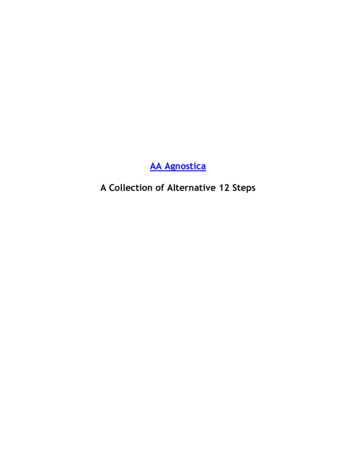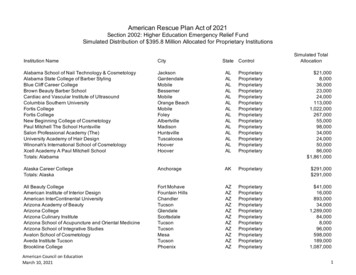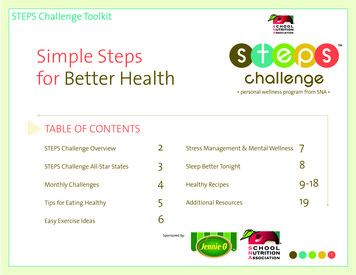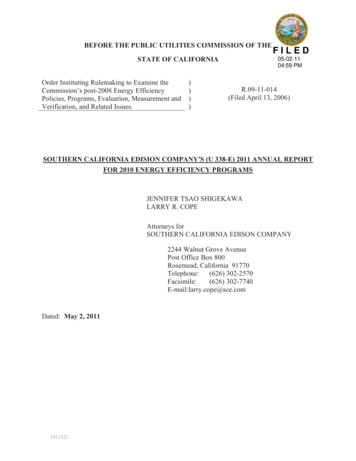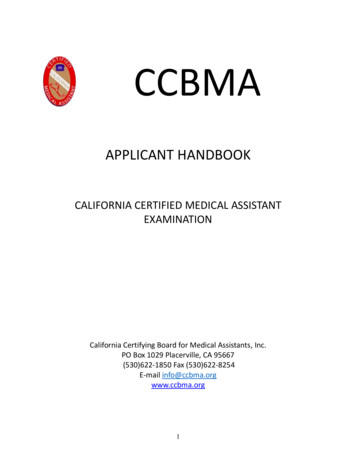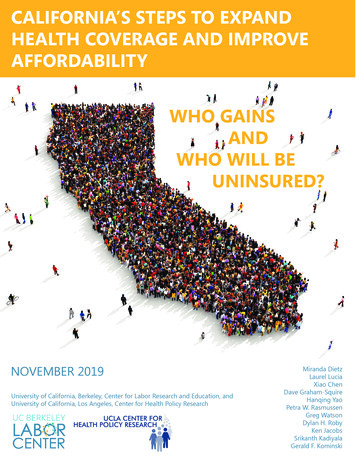
Transcription
California’s Steps to Expand Health Coverage and Improve Affordability: Who Gains and Who Will Be Uninsured?1
Executive SummaryCalifornia’s success in implementing the Affordable Care Act resulted in the number of uninsuredfalling from 6.5 million in 2013 to 3.5 million in 2017. At the end of 2017, Congress voted toeliminate the individual mandate penalty starting with the 2019 tax year, a change projected toincrease the uninsured by more than half a million Californians.In 2019, state lawmakers took steps to protect California’s coverage gains and increase affordabilityof coverage by instituting a state individual mandate penalty, providing additional subsidiesfor Covered California’s individual market enrollees, and expanding Medi-Cal to low-incomeundocumented young adults. California is the first state to include undocumented adults in fullMedicaid benefits and the first to provide subsidies to middle-class consumers not eligible underthe ACA.We model these policies using CalSIM, our micro-simulation model of insurance take up in California,and project that in the absence of these policies premiums in the individual market would be higherand the number of uninsured in California would climb to 4.3 million by 2022. On the other hand,with these policies in place, we project the number of uninsured will remain stable at 3.5 million.We estimate that by 2022, these policies will have prevented 770,000 Californians from becominguninsured (Exhibit 1) and will have reduced premiums for 1.55 million Californians, benefitting a nettotal of 2.2 million Californians (Exhibit 2).Exhibit 1. Millions of uninsured and uninsured rate among Californians age 0–64Number of uninsured (in millions)and uninsured rate amongCalifornians age 0–6476.5m / 17.6%6If no action had been taken4.27m / 12.9%5} 770,00043.47m / 10.4%3Under CA policy3.52m / 22Note: All estimates in this report are based on a definition of insurance that excludes restricted-scope Medi-Cal for undocumented CaliforniansSource: CalSIM version 2.7 and California Health Interview SurveyCalifornia’s Steps to Expand Health Coverage and Improve Affordability: Who Gains and Who Will Be Uninsured?2
Exhibit 2. Impact of California policies in 2022Number benefiting from California’s recent health reform policiesAverage premiumcontribution reductions770,000 gain or retain coverage as a result of policies680,000 enrolled in the individual market with incomes 200–400% FPL pay lowerpremiums as a result of additional state subsidies–8%120,000 enrolled in the individual market with incomes 400–600% FPL pay lower premiumsas a result of state subsidies–43%750,000 enrolled in the individual market pay lower premiums as a result of healthier riskmix in individual market–8.5%Net number of Californians who benefit: 2.2 million* relative to projections if no action had been taken* Total accounts for 160,000 Californians who are included in both the group that gains or retains coverage, and one of the groups with lower premiums.For more details see Exhibit 9.Source: CalSIM version 2.7.Nonetheless, 3.5 million Californians under age 65 will still be uninsured in 2022 (Exhibit 3). Thelargest group among the uninsured will remain undocumented Californians. Nearly 1 millioncitizens or lawfully present immigrants are projected to be eligible for Covered California but remainuninsured, most of whom (610,000) have family incomes that are under 400% of Federal PovertyLevel (FPL). For this group of uninsured,affordability is the biggest barrier toExhibit 3. Uninsured Californians age 0–64enrollment.3.5 million550,000Eligible for Employer Coverage370,000Eligible for Covered CA, over 400% FPL610,000Eligible for Covered CA, under 400% FPL660,000Eligible for Medi-Cal1,340,0002022UndocumentedCalifornians who are low-income, Latino,or adults under age 50 are projected tocontinue to be more likely to be uninsured.These projections of how many and whichCalifornians will remain uninsured canhelp inform state policymakers and theHealthy California for All Commissionas they consider options to make healthcoverage more universal and affordable.Possible steps range from those that canbe taken in the near-term without federalapproval to a more fundamental overhaulof our state health care system, such asadopting a single-payer plan.Source: CalSIM version 2.7California’s Steps to Expand Health Coverage and Improve Affordability: Who Gains and Who Will Be Uninsured?3
IntroductionThe Affordable Care Act covered millions of Californians and brought the number of uninsured tohistoric lows by increasing access to coverage and by providing financial assistance to cover thecosts of insurance.1 However, health care costs in the United States continue to pose affordabilitychallenges and remain significantly higher than in other countries.2 Since 2017, federal policydecisions that threaten to reverse the ACA coverage gains have led states to consider how to shoreup the gains they have achieved, stabilize the individual market, and improve on the ACA.3 ManyCalifornia policy makers have expressed a desire to get to universal coverage, and California’s2019–2020 budget included a number of provisions focused on expanding health insurancecoverage and improving affordability in the individual market beginning January 2020. This reportdetails the projected effects of three key policies on coverage and affordability of individual marketpremiums, as well as the demographics of who will be helped by these policies. We also describe the3.5 million Californians who are projected to be uninsured in 2022,4 highlighting the need for furtherstate action to expand coverage and improve affordability.We model the effect of these new health coverage policies using the California Simulation ofInsurance Markets (CalSIM) version 2.7, a microsimulation model of health care coverage anddecision making for the California population under age 65. CalSIM models the behavior ofCalifornia employers (to offer or drop health insurance coverage) and individuals (to take up varioushealth insurance offers for which they are eligible). The model accounts for population growth,minimum wage increases at the state and local levels, and premium growth in both the individualand employer markets. We calibrate the model to 2017 using California survey and administrativedata on insurance coverage, and then project forward two different scenarios: (1) with recentCalifornia-specific policies, and (2) the counterfactual without those recent policies, keeping stateand federal policies as they were at the beginning of 2019.5California’s PoliciesUsing CalSIM, we model three policies passed by the California legislature and signed by theGovernor in 2019, to begin in 2020:1.the expansion of Medi-Cal to undocumented young adults;2. state advance premium tax credit subsidies for individual market coverage for those200–400% FPL and 400–600% FPL; and3. an individual mandate penalty.Other state changes enacted in 2019 that are not modeled in CalSIM due to data limitations orlimited evidence about the anticipated impact on enrollment include: state premium subsidiesfor those enrolled in Covered California with income at or below 138% FPL; additional fundingfor outreach and enrollment; automatic enrollment when transitioning from Medi-Cal to CoveredCalifornia;6 and changes to Medi-Cal eligibility for adults age 65 and over. As we discuss below, thelikely disenrollment due to changes to the federal “public charge” rule and other policies affectingimmigrant families is also not included in our projections.7California’s Steps to Expand Health Coverage and Improve Affordability: Who Gains and Who Will Be Uninsured?4
1. Medi-Cal for all young adultsCalifornia expanded Medi-Cal eligibility to include low-income adults ages 19 to 25 regardless ofimmigration status, starting in 2020.8 Children age 18 and under have already been eligible since2016 under state policy. The governor has committed to working with the legislature in 2020to expand eligibility to undocumented adults age 65 and over9 and has expressed support foreventually covering low-income Californians of all ages under Medi-Cal.2. State subsidiesCalifornia will provide premium subsidies for three groups of Californians enrolled in the individualmarket through Covered California (Exhibits 4 and 5).1. Income at or below 138% FPL: This group is already eligible for ACA subsidies; afterimplementation of state subsidies they will pay 1 monthly premiums, making costsmore parallel with Medi-Cal enrollees at the same income level who pay no premiums.This group is not modeled in CalSIM. Approximately 24,000 subsidized Covered Californiaenrollees fell into this income range as of March 2019.102. Income 200–400% FPL: This group is also already eligible for ACA subsidies, and will beeligible for state subsidies that will lower premium contributions by 0.1 to 0.88 percent ofhousehold income, depending on FPL.3. Income 400–600% FPL: This group has income above the ACA “cliff” beyond whichthere are no ACA subsidies; state subsidies will provide premium assistance to this groupfor the first time, limiting premium contributions to between 9.68 percent and 18 percentof income, depending on income level.11No additional state subsidies were given to households with incomes between 138–200% FPL.Massachusetts and Vermont also offer state subsidies to those with incomes below 300% FPL, but noother states currently offer subsidies to those over 400% FPL.12Exhibit 4. Covered California enrollees newly eligiblefor state subsidiesIncome as percent ofFederal Poverty LevelIncome for anindividual, 2020Income for afamily of four, 2020 17,237 35,535200–400% FPL 24,980 – 49,960 51,500 – 103,000400–600% FPL 49,960 – 74,940 103,000 – 154,500 138% FPLState subsidies are providedfor plan years 2020, 2021, and2022, with most of the fundingallocated to those with income400–600% FPL. Covered California may adjust the premiumcaps in future years as needed tomeet budget targets.13California’s Steps to Expand Health Coverage and Improve Affordability: Who Gains and Who Will Be Uninsured?5
Exhibit 5. Premium contribution caps under ACA and California policy, 2020Enrollee premiumcontribution cap(% of income)nouti18%16%14%Federal Contributionte tribatS onCEnrollee contribution capunder ACAEnrollee contribution capunder CA policy10%State Contribution6%Enrollee Contribution2%State Contribution0138%200%400%Income(% of FPL)600%3. State individual mandate penaltyThe federal individual mandate penalty was zeroed out starting in 2019. Massachusetts, Vermont,New Jersey, DC, and Rhode Island will have penalties in 2020.14 California’s individual mandatepenalty, assessed as part of state income tax, will be in effect starting January 2020 and will requireresidents to have minimum essential coverage for each month or pay a penalty when they file taxesin 2021. Both the penalty amount and exemptions generally mirror the ACA tax penalties that werein place prior to 2017.15CalSIM models the California penalty as being very similar in effect to the federal penalty. We dotake into account the higher tax-filing threshold in California that will result in fewer householdspaying the penalty and slightly lower penalty amounts than would have been the case under thefederal penalty. However, because we model most of the effect of the penalty as psychological (andunrelated to whether someone actually would have to pay it and the exact amount that it would be),the projected effect on insurance take-up is very similar under the state and federal penalties.16 Weassume that awareness of the state penalty is similar to awareness of the federal penalty: some areunaware the federal penalty ever went away; for them the penalty effect remains constant, despiteone year without one. Others may know that the federal penalty was zeroed out but will learn of thestate penalty when they file taxes. In our projections we focus on 2022, assuming that in the absenceof California’s new policies the effects of eliminating the federal penalty would have phased in overtime, with the full effects evident by 2022.California’s Steps to Expand Health Coverage and Improve Affordability: Who Gains and Who Will Be Uninsured?6
The effect of an individual mandate penalty is that more and healthier people enroll in coverage. Weassume that one of the ways the penalty works is as a “nudge” to encourage those losing insurancecoverage to shop or apply for coverage.17 This especially affects enrollment among those eligible forMedi-Cal, despite the fact that they are often exempt from paying the penalty, because they may notknow they are eligible for free coverage under Medi-Cal until they shop. The other way the penaltyincreases enrollment is by encouraging enrollment among healthier individuals, resulting in lowerpremiums for everyone. When premiums are lower, more people enroll.Resulting individual market premiumsAs a result of the state individual mandate penalty and state subsidies keeping more people in theindividual market, we project that premiums in the individual market will be 8.5 percent lower in2022 than they otherwise would have been due to a healthier risk mix in the individual market. Withthese policies, we assume baseline premium increases each year of 7 percent due to medical costgrowth. Without these policies, we assume premiums by 2022 are an additional 8.5 percent higherthan the baseline.Estimates do notinclude anticipateddisenrollment fromMedi-Cal due tovariety of policiesaffecting immigrantfamilies including thepublic charge ruleThe uninsured projections in this reportproficiency, limited educational attainment,do not include any decline in Medi-Calor low income.enrollment among immigrant families dueIt is anticipated that if this rule isto the growing fears resulting from a rangeimplemented, immigrant families would faceof immigration policies proposed federally.18fear and confusion about the consequencesOne policy expected to have a particularlyof enrollment in public programs, resultinglarge impact on health insurance enrollmentin a “chilling” effect on enrollment inis the recent Department of Homelandprograms such as Medi-Cal and CalFreshSecurity rule commonly referred to asfood assistance. Research by the UCLA Centerthe “public charge” rule.19 As of the date offor Health Policy Research, UC Berkeleypublication of this report, implementation ofLabor Center, and California Food Policythe final rule has been halted by injunctionsfrom multiple federal courts.20 Under the rule, Advocates estimated that if 15 to 35 percentof Californians in immigrant families subjectwhen a person applies for lawful permanentresidency (a “green card”) or for a visa to enter to this chilling effect disenroll from publicprograms, between 317,000 and 741,000the country, U.S. immigration officials wouldfewer Californians would have Medi-Calconduct a public charge test to determine if21that person may become primarily dependent coverage, most of whom would become22on the government to meet their basic needs. uninsured.Under the public charge test, the DepartmentWhile the research is clear that the publicof Homeland Security could deny someonecharge rule is likely to result in lowera green card or visa based on enrollmentMedicaid enrollment in California andin certain health care, housing, or nutritionnationally, we have not yet incorporated theassistance benefits or having certain personalrule and its effects into the CalSIM model.circumstances such as limited English7
Who Gains?770,000 gain or retain coverageThese California policies are projected to result in 770,000 more Californians with health insurancecoverage in 2022 than if these policies were not in place. Largely, the policies help Californians retaincoverage, keeping the number of uninsured in California essentially constant at 3.5 million. Theprojected number of uninsured Californians would increase over the coming years if these policieswere not in place.Without the individual mandate penalty in place, we project the individual market would shrinkand premiums would increase. Covered California estimated that premiums in 2019 were 3.5 percenthigher than they would have been if the mandate penalty had not been zeroed out,23 and weproject premiums would have increased even more in future years without state action. By 2022, thecombination of the individual mandate, lower premiums, and additional state subsidies will result in210,000 more individual market enrollees than if these policies were not adopted, an increase of 11percent.The individual mandate is also projected to affect Medi-Cal enrollment; without the extra nudgeto shop for insurance, fewer people enroll in or discover they are eligible for Medi-Cal. In additionto the effect of the individual mandate, the expansion of Medi-Cal to undocumented young adultsresults in an increase of approximately 100,000 new full-scope Medi-Cal enrollees. The overall effectof 510,000 Californians who gain or retainMedi-Cal coverage by 2022 amounts to a 6Exhibit 6. Change in coverage due to policies,percent change in enrollment in Medi-CalCalifornians age 0–64, 2022among those age 0 to 64.Individual MarketMedi-CalEmployer Sponsored InsuranceUninsured (Total) 210,000 510,000 60,000– 770,000Column does not add due to roundingSource: CalSIM version 2.7The employer-sponsored insurance market—still the source of coverage for the majorityof Californians under age 65—is largelyunchanged by these policies. We project60,000 Californians gain or retain coverage by2022 as a result of the individual mandate, anincrease of less than 1 percent.The demographics of this group of 770,000 individuals reflects the fact that the majority are enrolledin Medi-Cal coverage, with a disproportionate share being in low-income households (see AppendixExhibit A1).800,000 Californians get state subsidiesState subsidies will lower the contribution cap for those with incomes 200–400% FPL and will providea contribution cap for the first time for Californians with incomes 400–600% FPL.We project that in 2022, 680,000 Californians with incomes 200–400% FPL will get state subsidiesthat average 15 per person per month, in addition to their federal subsidies. These state subsidieslower premiums for these enrollees by an average of 8 percent.Our estimates for how many will receive subsidies are largely in line with Covered California’s estimate ofCalifornia’s Steps to Expand Health Coverage and Improve Affordability: Who Gains and Who Will Be Uninsured?8
Comparison toEstimates fromCovered CA235,000 having income400–600% FPL in 2020and being eligible forsubsidies by virtue ofhaving insurance throughthe individual market.24We project 260,000Californians in this groupin 2022 (Exhibit 7). Ofthese 260,000, we projectthat 120,000 will havepremium costs that exceedthe contribution cap fortheir FPL and therefore geta positive dollar subsidy(and count among the800,000 receiving statesubsidies). Another 140,000Californians have incomes400–600% FPL and willpurchase coverage onthe individual marketbut are not projected toreceive a subsidy in 2022because their unsubsidizedpremiums already costless than the cap (9.68 to18 percent of householdincome). They will, however,count among the 750,000who benefit from lowerpremiums in the individualmarket, as discussed below.Another 120,000 Californians with income above the federal “cliff” of400% FPL but below 600% FPL will get state subsidies that average 310per person per month. This amounts to a 43 percent lower premium, onaverage, than if people had enrolled in the same plan without subsidies.Many of these enrollees would have had individual market coverage evenin the absence of state policies, but the state subsidies provide substantialfinancial help. Because premiums increase with age, most of those who hitthe premium contribution cap and receive these subsidies (65 percent) areages 50–64 (Exhibit 7). Most are either self-employed (52 percent) or thespouse or child of someone who is self-employed (another 16 percent). Theremainder are either not working or working part-time; very few full-timeworkers in households with income 400–600% FPL lack an affordable offerof employer based insurance (a requirement for subsidy eligibility).Taken together, this group of 800,000 individual market enrollees newlyreceiving state subsidies is projected to be somewhat more likely to bewhite and age 50 or older than the overall individual market universe,defined as those either enrolled in the individual market or uninsured andeligible (see Exhibit 8).While the majority of the people getting state subsidies will be under400% FPL (680,000), most of the money will be spent on the 120,000 withincomes 400–600% FPL, as budgeted.25Exhibit 7: Who are California’s 260,000 individual market enrollees400-600% FPL in 2022?140,000 enrollees do notget subsidies because theirpremiums are below the cap120,000 enrollees getsubsidies that average 310 per person per month140,000120,000No subsidiesGet state subsidiesAgeEmploymentMost of those getting subsidiesare age 50 or older35%65%Under 5050–6452%16% 32%Most of those getting subsidiesare self-employed or thedependent of someone who isSelf-employedFamily memberof self-employedSource: CalSIM version 2.7Other (mostly part-timeor not in the workforce)9
750,000 benefit from lower premiums in the individual marketAs a result of the individual mandate penalty and state subsidies, we project that the risk mix inthe individual market under these policies will be somewhat healthier than without the policies.As a result, premiums in the individual market in 2022 are projected to be 8.5 percent lower thanthey would have been without state action. Passage of the additional subsidies and state mandatepenalty has already played a key role in driving down premium growth in 2020 according to CoveredCalifornia.26Individual market enrollees who receive subsidies are shielded from the increase in premiums bydesign—their contribution is a function of their income. However, individual market enrollees whodo not get subsidies face the full cost of coverage and thus benefit from lower prices. Californiansare ineligible for subsidies if they meet any of these criteria: Have income above 600% FPL; Have premiums low enough that they do not exceed the contribution cap(which extends up to 18 percent of family income for those at 600% FPL); Have an “affordable” offer of employer-sponsored coverage; Are eligible for public coverage such as Medi-Cal, Medicare, or VA health benefits; or Are undocumented.750,000 Californians are projected to be enrolled in the individual market without subsidies in 2022and therefore will benefit from these lower prices. Unsubsidized individual market enrollees areconcentrated in higher income groups and, similar to the individual market universe as a whole, aremore likely to be white than the overall California population age 0–64 (Exhibit 8).The overall effectAs a result of these policies, California will see 770,000 more insured in 2022 than if these policieswere not in place, and 1.55 million Californians will benefit from lower premiums, either as a result ofsubsidies or lower prices. There is overlap between these groups, however, as illustrated in Exhibit 9.On net in 2022 we project that 2.2 million Californians will benefit from coverage and/or affordabilityhelp as a result of California’s policies.Of the 800,000 Californians getting subsidies, we project that the majority (720,000) would have beeninsured even in the absence of these policies, while 80,000 would have been uninsured. These 80,000gained or retained coverage as a result of the individual mandate penalty and/or additional subsidies.Similarly, of the 750,000 individual market unsubsidized enrollees, most (670,000) would have hadinsurance even in the absence of these policies, despite premiums being 8.5 percent higher. However,80,000 would be uninsured in the absence of these policies; they gain or retain coverage as a resultof either the individual mandate or the lower premiums in the individual market.California’s Steps to Expand Health Coverage and Improve Affordability: Who Gains and Who Will Be Uninsured?10
Exhibit 8. Demographics of Californians projected to receive state subsidies or pay lower premiums inthe unsubsidized individual market, 2022Pay Lower Premiumsin UnsubsidizedIndividual MarketGet ansAge 0–64Latino190,00023%190,00025%31%40%Asian, not Latino130,00016%130,00017%13%13%African American, not Latino20,0003%30,0004%4%6%White, not Latino450,00057%390,00052%50%40%Other, multiracial, not Latino10,0001%10,0002%2%3%0–18 years110,00014%210,00028%12%29%19–29 years150,00019%100,00013%23%19%30–49 years220,00028%270,00036%34%30%50–64 years310,00039%170,00023%32%22%150,00021%25%40% 200% FPL200–400% FPL680,00085%180,00024%41%25%400–600% 00100%100%100%600 % FPL800,000100%Note: Individual Market Universe includes those enrolled in the individual market or uninsured but eligible for the individual market throughCovered California, excluding Medi-Cal eligible uninsured and undocumented uninsured.Numbers may not add due to rounding.Source: CalSIM version 2.7Exhibit 9. 2.2 million Californians are projected to benefit from California’s policies in 2022770,000 gain or retain coverage770,000 gain orretain coverage80,000750,000 paylower premiums80,000800,000 receivestate subsidies1.55 million benefitfrom lower premiumsSource: CalSIM version 2.7California’s Steps to Expand Health Coverage and Improve Affordability: Who Gains and Who Will Be Uninsured?11
Who Is Uninsured?Even with these policies in place, 3.5 million Californians are projectedto be uninsured in 2022, and disparities by race and ethnicity, income,and age persist among this group. Below we identify and enumerate thedifferent groups of those who are uninsured on the basis of their eligibilityfor various existing programs.The largest group of the projected uninsured are 1.34 millionundocumented Californians. Low-income undocumented Californiansover age 25 continue to be ineligible for full-scope Medi-Cal coverageunless they have DACA.31 Many of these individuals have restricted scopeMedi-Cal, which we do not count as insurance because doctor visits,hospital care, prescription drugs, and other basic health services are notcovered unless they are necessary for the treatment of an emergencymedical condition or the enrollee is pregnant. (Covered services do notinclude, for example, most of the care needed by someone with cancer,diabetes, or many other conditions.32) Categorizing restricted scopeMedi-Cal as uninsurance makes an important difference in our estimates.Survey-based estimates of uninsurance generally rely on self-reportedinsurance status without adjusting for scope of coverage. Since someundocumented adults report having Medicaid coverage, survey-basedestimates generally report fewer uninsured than our CalSIM estimates.Most Californians who are both undocumented and uninsured haveincomes below the Medi-Cal threshold; those with incomes above thethreshold are not eligible for federal or state premium subsidies to helpafford private coverage. While some undocumented Californians enrollin coverage through their employers, undocumented adults are amongthe least likely to have job-based coverage in spite of their high rate ofemployment.33We project that 660,000 Californians who are eligible for Medi-Calwill nevertheless be uninsured in 2022. While more than 90 percent ofthose eligible for Medi-Cal are projected to enroll, the remainder may notrealize they are eligible or may not try to enroll for other reasons.34 Thoseeligible for Medi-Cal can enroll at any time of year, unlike those eligible forindividual market coverage who can only enroll during the annual openenrollment period or if they experience a qualifying life event (e.g., divorce,job loss, etc.). Our projection does not take into account the chilling effecton enrollment that is likely to occur if the Trump administration’s changeto the public charge rule, currently halted by the courts, is implemented.On the other hand, in 2019 California made a budget investment tosupport community-based outreach by health enrollment navigatorsto provide enrollment, retention, and utilization assistance to Medi-Caleligible individuals;35 our projection does not take these potential impactsinto account either.California’s Steps to Expand Health Coverage and Improve Affordability: Who Gains and Who Will Be Uninsured?HealthInsuranceMattersHealth insurance coverageplays a significant rolein facilitating access toneeded health care.27 Recentevidence suggests thathealth insurance protectsindividuals from financialdistress and excessiveout-of-pocket spending,encourages earlier diagnosisof chronic conditions,improves use of preventiveservices, and reducespreventable mortality.28 Theshort-term gains resultingfrom insurance coverageexpansions in the ACAinclude improved coverageand reduced disparities inaccess to care, improveduse of preventive services,improved affordabilityof health care, improvedhealth status, increasedprescription drug useand adherence, improvedaccess to mental healthtreatment, and improvedhealth status and mentalhealth among the chronicallyill.29 Insurance coverage islinked to obtaining a usualsource of care, which reducespreventable mortality andout-of-pocket spending onhealth care by individuals.3012
Exhibit 10. Uninsured Californians age 0–64 by eligibility category and income, 20223.5 million190,000600 % FPLEligible for Employer Coverage550,000Eligible for Covered CA, over 400% FPL370,000180,000400–600% FPLEligible for Covered CA, under 400% FPL610,000Eligible for Medi-Cal*660,000970,000 eligiblefor Covered CA410,000200–400%
Insurance Markets (CalSIM) version 2.7, a microsimulation model of health care coverage and decision making for the California population under age 65. CalSIM models the behavior of California employers (to offer or drop health insurance coverage) and individuals (to take up various healt

